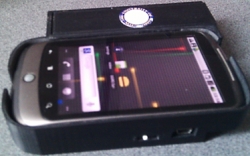UW Dietary Recorder Offers Phone-Based Laser-Assisted Weight Loss
The Dietary Data Recorder System (DDRS) automatically calculates nutritional balance, using a laser grid and a mobile phone. Near real-time functionality allows users to actively monitor their eating habits, facilitating informed and consistent dietary choices.

Seattle, WA, November 28, 2011 --(PR.com)-- The Sensors, Energy, and Automation, Laboratory at the University of Washington, in partnership with the Fred Hutchinson Cancer Research Center, has completed development of a prototype Dietary Data Recorder System (DDRS). The DDRS enables users to automatically calculate and log the caloric content of over nine thousand types of food, through the use a laser grid and a camera-equipped mobile phone. The device functions in near real-time, allowing users to view an up-to-date summary of their daily eating habits, and granting them the awareness necessary to make better choices.
The highly accurate, automated measurements that the DDRS provides transcend the capabilities of traditional dietary intake monitoring systems, which typically rely on manual estimation to calculate the caloric content of food. “Through laser-based 3D reconstruction,” explains Ph.D. candidate Junqing Shang, “the DDRS creates volumetric representations of food and beverages.” When coupled with a robust nutritional database and a powerful back-end server, the DDRS can calculate energy intake on the fly, allowing doctors, researchers, and health-conscious individuals, to observe objectively even the smallest details about eating habits.
The DDRS can currently measure everyday food items with roughly 90% accuracy, including among its recordings not only caloric content information, but also advanced nutritional information, location, time of day, and more. With this wide array of simultaneous measurements, the DDRS provides the foundation for a high-level of complex behavioral analysis that will undoubtedly improve dietary and medical research and change lives.
###
The highly accurate, automated measurements that the DDRS provides transcend the capabilities of traditional dietary intake monitoring systems, which typically rely on manual estimation to calculate the caloric content of food. “Through laser-based 3D reconstruction,” explains Ph.D. candidate Junqing Shang, “the DDRS creates volumetric representations of food and beverages.” When coupled with a robust nutritional database and a powerful back-end server, the DDRS can calculate energy intake on the fly, allowing doctors, researchers, and health-conscious individuals, to observe objectively even the smallest details about eating habits.
The DDRS can currently measure everyday food items with roughly 90% accuracy, including among its recordings not only caloric content information, but also advanced nutritional information, location, time of day, and more. With this wide array of simultaneous measurements, the DDRS provides the foundation for a high-level of complex behavioral analysis that will undoubtedly improve dietary and medical research and change lives.
###
Contact
SEAL
Alexander Mamishev
(206) 221-5729
www.ee.washington.edu/research/seal/
Alexander Mamishev
(206) 221-5729
www.ee.washington.edu/research/seal/
Multimedia

Downloadable PDF
This PDF version of the release includes an additional diagram depicting the standard usage of the DDRS.
Categories
